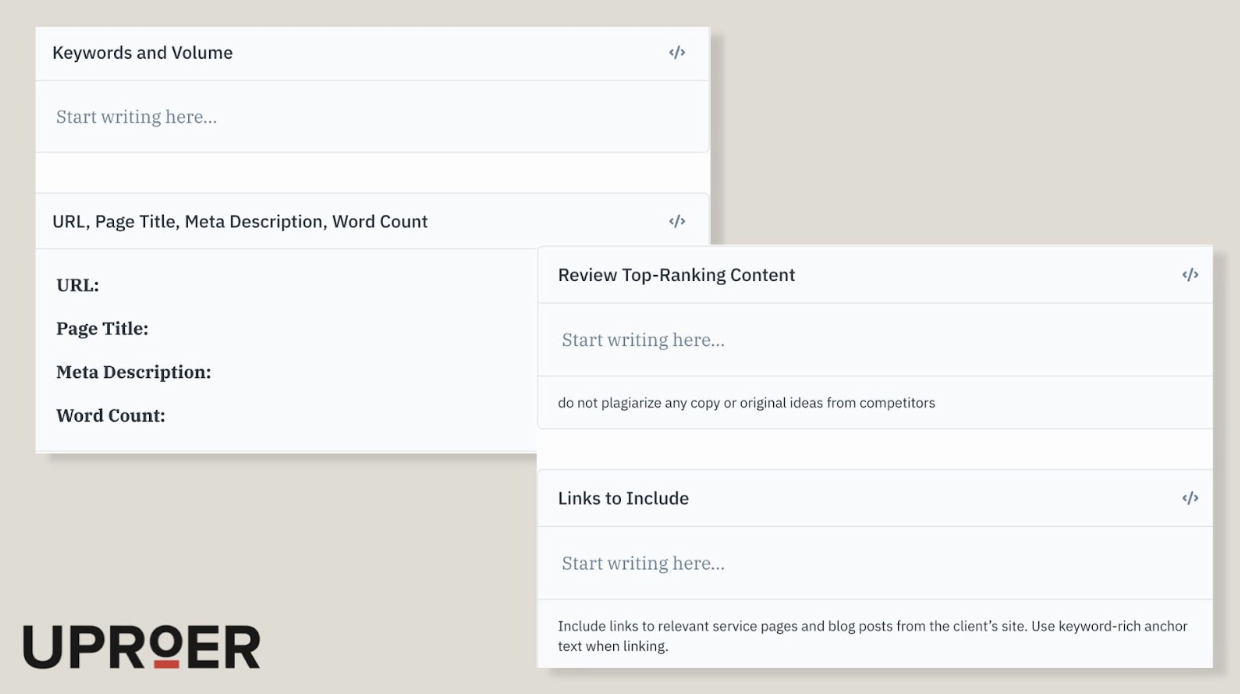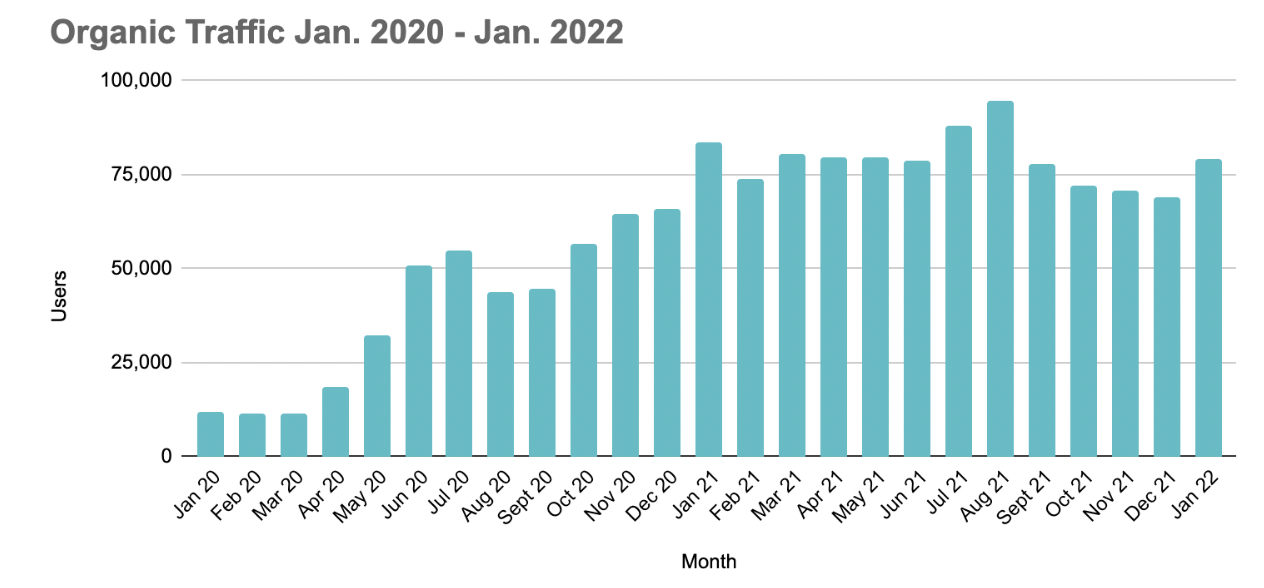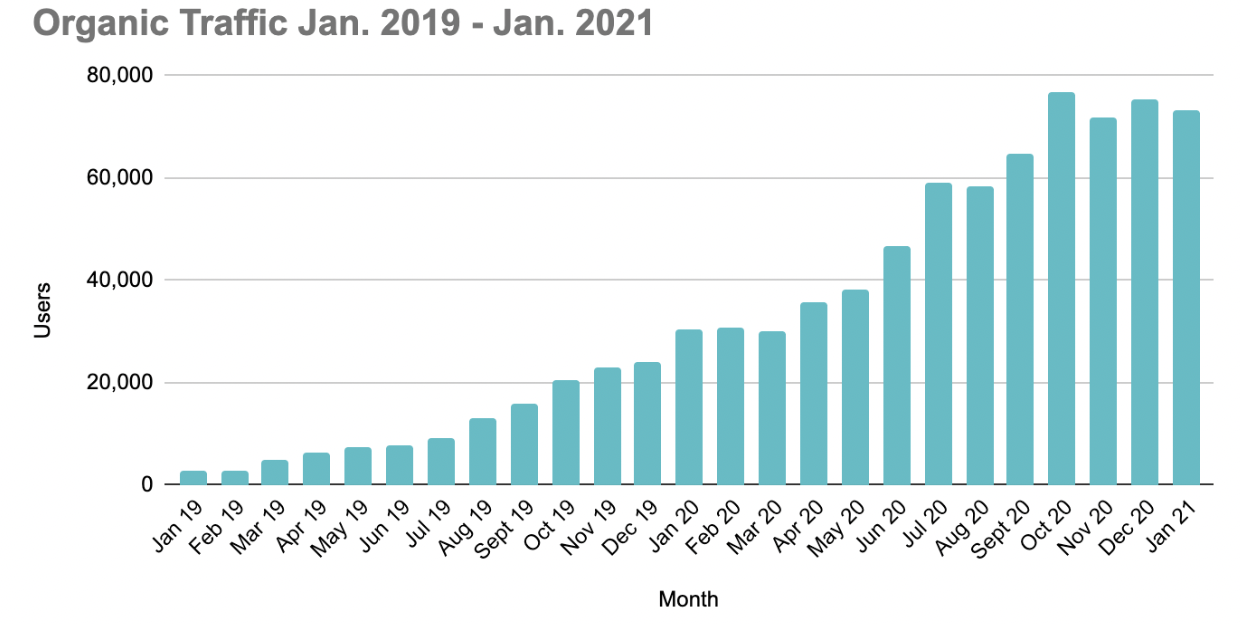Table of Contents
A site can check all of the SEO best practice boxes, but if the copy is poor, your audience won’t convert. As a small but mighty SEO agency, this is something Uproer keeps top of mind.
The benefits of having good copy on a site are endless. Good copy is clearly written, on-brand, and targeted to aid in eventual conversion. It helps to establish brand authority and trust, and it’s what keeps customers coming back.
The goals of the copywriting services at Uproer are:
- Deliver consistently high-quality, search-optimized content in an organized and timely manner
- Foster client and copywriter relationships built on trust and collaboration
- Help achieve client objectives in the form of conversions, traffic, and other KPIs
- Create a strategic content workflow that works like a well-oiled machine for each engagement
We’ve established seven fundamental approaches that help us reach these goals:
Approach #1: Source experienced writers *far* in advance of client engagement
Keyword “far” on this one, agencies are fast-paced! This means it’s easy to push off finding a writer when you have a bunch of other things on your plate. The issue here? The less time you spend sourcing a writer, the lower the odds of finding one that has your desired capacity.
Of course, this is easier said than done. But, everything's better with a buffer. During the first month of strategy development, we audit the client’s site and find a writer on their behalf. Finding a writer can be a tricky process, but we have some tips on where to start. Check it out below:
Where to find “The One”
Uproer partners with ecommerce and Saas companies in a wide variety of industries, which means we're producing content focused on countless topics. We’ve found that vetting copywriters that have experience in specific industries is the best way to create authoritative content that requires minimal editing.
There are several ways to source affordable copywriters that specialize in specific industries. Some of our favorite tactics include:
- Slack Communities: Casting a blanket message to #copywriting channels on Slack communities like Women in Tech SEO has proven to be a successful way to find reliable and experienced copywriters in specific fields. Once we connect with a prospective writer, we hop on a call to get a feel for their work process and experience. This is also a great time to ask them specific questions about the client’s industry to make sure they know their stuff!
- Content Marketplaces: Superpath and Verblio are two examples of ways to partner with vetted copywriters that specialize in your desired industry.
- Twitter/LinkedIn. Our team is active and engaged on social media platforms, allowing us to source and connect with writers across industries.
- Copywriting Agencies: Uproer partners with copywriting agencies on some client projects. Copywriting agencies are able to crank out a large amount of monthly articles (for some we’re talking 8+!). Great copywriting agencies are reliable, and are able to produce high-quality content that meets just about any deadline. Plus, some agencies may specialize in the exact areas you’re looking for.
- Conferences: It’s no secret that conferences and events are goldmines for networking. While it may take some more planning, this can also apply to connecting with writers and freelancers who are eager to work. Many of our copywriters were found through connections we met during networking calls and conferences.
- Internal Writers: Depending on the nature of the project and the goals of the client, sometimes Uproer employees take on the copywriting.
Strategies for outreach
2-3 weeks before the first touch base with a new client, we begin searching for copywriters. We generally like to connect with 2-3 copywriters to gauge interest and availability. This includes reaching out to copywriters that are already in our list of contacts, or finding new writers that can help with a specific project.
Here is an example of what a typical outreach note looks like when we’re looking for a new writer:

Things to include in an outreach message:
- Client’s industry, not the brand name (unless the copywriter is already familiar)
- Word counts
- Number of pieces
- Due date and/or start date
- Any prerequisites for the copywriter
Once we’ve connected with a new copywriter, we like to have them complete a paid “test” article. These articles help copywriters get a feel for our outlines and content process. They also allow us to get to know their writing style. We've found most copywriters are open to this idea, and it's a great way to provide productive feedback.
After we seal the deal with a writer, we send a follow-up with more information about the project and the client. Before the writer starts the project, we make sure they have what they need to succeed. More on that next!
Approach #2: Set copywriters up for success
NEWS FLASH: The more information a copywriter has about a piece of content, the better the content will be. We don’t want to send copywriters off with one keyword or topic idea and let them try to fill in our blanks. This may seem like a “well, duh” moment, but it’s something that we’re always working to get better at.
Here’s how Uproer sets copywriters up for success:
Content Outlines
Behind every great article is a thorough content outline. It’s where the ✨ magic ✨ happens.
Our content outlines bridge the gap between the client’s knowledge and the copywriter's writing skills. We start with the basics: target keywords, metadata recommendations, and heading structure. But, we don’t stop there. Beyond the SEO guidelines, we include:
- Insights on what top ranking sites are doing well
- Specific notes on target audience and brand voice
- Link to brand guidelines when applicable
- Link to products and other internal pages that should be featured in the article
- Link to external pages that should be featured in the article
- Note any important features about a product or service that should be mentioned
Here's a sneak peek of what this looks like:

Tip: Add a “Content Brief” section to whatever you use to create outline templates. This should include high-level information about voice, brand guidelines, and target audience. This also acts as an editing guideline for the client.
The bottom line here is that no copywriter should be left in the dark. While it may take some extra time to create an outline, it will eliminate some of the editing time on the backend. Plus, the client will be happy with the consistent quality in content
Tools That Maximize Efficiency
As Uproer continued to grow in 2021, inefficiencies surfaced in our content process. Communication was being lost in a tangled web of email and Slack threads. As a result, key information like content due dates were getting lost in translation.
In order to stabilize our content workflow and communication, we turned to GatherContent. GatherContent is a tool designed to help companies standardize their content operations. It’s incredibly user-friendly, and it allows collaboration across all stages of content production. Plus, we have clear visibility on which projects writers are assigned to.
Today, all of our outlines and drafts are created in GatherContent. Once clients and copywriters are added to a project, they’re assigned to different stages of production.
Having one tool for managing content has improved the way we collate feedback from a client and convey it to a copywriter. Most importantly, GatherContent established a more consistent content production process across all of our client engagements.

Convey the “Uproer Way”
At the beginning of a relationship with a new copywriter, setting expectations is a crucial part of providing a beneficial experience for them, for us, and for our clients.
This can be as simple as hopping on a 15-minute call with the writer to review our process and answer any questions. We want to make sure they know the purpose behind each piece of information we give them. Building a strong stable of writers takes time, and it starts with developing trust before the first article is written.
Approach #3: Encourage collaboration during client engagements
We also want to convey the “Uproer Way” to our client partners. By setting expectations for the content process at the beginning of the engagement, we hope to build a base for a strong and collaborative relationship.
From the get-go, we ask our clients if they’re willing to put in the effort to give us brand guidelines and other necessary information we need to produce content. If they can’t commit, content outlining is often the better fit. Because of this, there are two roads clients can take for working with us on content:
- Content Outlining: Uproer completes the outlines and creates a content strategy. Client uses the outlines as guidelines for internal writers.
- Content Creation: Uproer completes the outlines and creates a content strategy. Topics and outlines are approved by the client, then we send to Uproer writers.
We also like to acknowledge that there will likely be issues, especially at the beginning of an engagement. To help smooth out any bumps we come across, we offer a “test” article to clients before publishing. The first month of content production activities are limited to this test article, and soliciting feedback.
This is an opportunity for clients to get used to GatherContent. It’s also an opportunity for them to give as much feedback as possible, in a low-stakes environment with no harsh deadlines.
Approach #4: Strive for consistent quality across all clients
Part of establishing a client relationship built on trust is delivering consistent results, especially when it comes to copy. Copy consistency doesn’t happen without a solidified content workflow. It may seem simple, but when the workflow isn’t organized, feedback and important information can get lost in a sea of email threads.
This is where bridging the gap between clients and copywriters becomes especially important. With every engagement, we work to develop a firm process for client feedback that includes documentation for copywriters. If clients express feedback during a bi-weekly check-in, we are diligent about communicating that feedback to the copywriter.
We do this by adding any specific notes from the client in the brief tab on our content outline templates. We also ensure that all roles are assigned in GatherContent before a piece is written. Here’s an example of the stages of our workflow:
- Outline - Assigned to Uproer
- Client Review - Assign to client for review
- Draft - Assigned to Copywriter in GC
- Uproer Review
- Client Review - Assigned to Client in GC
- [Optional] - Assign to client’s legal or brand team for review
- Uproer Revisions
- 2nd Client Review - Assigned to Client in GC
- [Optional] - Assign to client’s legal or brand team for final review
- Final Uproer Edits
- Ready for Publish - Assign to Client for publishing
At the beginning of the engagement, we’ve found it helpful to set edit due dates for clients. It helps us stay on schedule, while also managing their expectations for when they can expect to read the drafts. This eliminates any chance of them editing or leaving comments before the draft is ready.
Approach #5: Strive for copy that speaks to humans *and* search engines
We can create a piece of content that drives traffic, but the real challenge is creating a piece of content that converts. The conversion rate, at the end of the day, is the KPI that matters most.
Sure, traffic and rankings are a huge part of SEO. But when we’re writing content, we want to create something that’s unique, empathetic, useful, and shareable. In other words, humans come first, search engines come second.
It’s important to note that conversions don’t always mean buying directly from a blog post. Conversions are any action a reader takes after reading the content, including:
- Newsletter sign-ups
- Comments
- Social follows
- Product page clicks
- Member sign-ups
- Quiz and survey responses
- And more, the opportunities are endless!
Achieving this empathetic and valuable content starts with our content outlines. We share as much information as possible from sources where the customers are talking. A few of our favorite places on the internet include:
- Reddit threads
- Social media
- Blog comments
- Interviews with client stakeholders (customer service reps, sales teams, marketers, etc.)
- Customer survey data (if available)
These are great areas to help copywriters tap into a specific audience’s pain points, while also getting a feel for what type of language to use. In the end, empathetic copy is what leaves the most meaningful impact.
Tip: Use the Hemingway App to check content for grammar errors and wordy sentences. This tool will also give an article a score for the “grade level” of readability. We shoot to have our copy fall around Grade 5 or 6.
Approach #6: Keep cross-channel promotion in mind
In an ideal world, we aren’t just creating content to help clients’ websites rank higher in search engines. Our content should be able to be used across all of our client’s marketing channels. The reason it is shareable across channels is because we create content with the audience’s pain points in mind. So any content we create will tie in nicely with our client’s other marketing efforts.
This is why we stay connected with our client’s social, sales, marketing and customer service teams to get insights on the audiences we write for. In some cases, social teams grant us access to their content calendars so that we can coordinate our SEO content strategies with their plans.
Example: One of our clients shares the content we write across their social media and email campaigns. During our check-in meetings, the client shares what content is drawing the most engagement on other channels. These insights help us understand what types of content resonate with the audience.
In the end, we strive for “shareable copy” that can simultaneously be published cross-channel and perform from an organic search perspective. Any information we gather from our client’s marketing teams is shared with the copywriter in our content outlines.
Approach #7: Ensure that each piece is optimized pre-delivery
We’re an SEO agency, after all. While we do push boundaries with creativity when it comes to writing for SEO, there are still some basics we like to adhere to. This includes:
- Headings are optimized and organized in correct structure
- Target keywords are strategically placed in copy
- Page title and metadata is optimized, but still “clickable”
- Important links are added
- Copy is readable for mobile devices
- Copy contains a compelling CTA
- Copy speaks to the correct audience
We typically partner with copywriters who have knowledge of SEO, and are able to implement these best practices into their writing. But, we still convey these guidelines within our content outlines. Before an article is sent to a client for review, we ensure that all of the boxes are checked from an SEO perspective.
Tip: Semrush’s Anatomy of Top Performing Blog Content in 2022 offers insight into the forms of content and copy that are performing from an organic perspective. We use their findings to enhance the content we produce for our clients. It’s definitely worth a read!
More work at the beginning of an engagement can have lasting positive effects
Before we wrap things up, let’s take a look at a few cases where Uproer’s copywriting approaches helped draw people to client’s sites:
Raw Bistro
Through Uproer’s copywriting method, we were able to triple organic traffic to Raw Bistro’s blog pages in a matter of months:

Want to learn more about the strategy we used? Check it out here: Case Study: Raw Bistro’s Traffic Grew by 849%
CaringBridge
After partnering with Uproer, CaringBridge’s Resources pages have seen tremendous growth, driving results worthy of the 2020 Search Engine Land Award for Best Overall SEO Initiative for Small Business.

Read more here: Case Study: CaringBridge Grew Blog Traffic by 356%
Copywriting is one small piece of the SEO content puzzle, but if it’s overlooked, your SEO strategy will not be effective. As we said before, great copy is what keeps people coming back.
If you want to work together to increase your company’s sales and leads through high-quality content and SEO strategies, let’s chat today!

